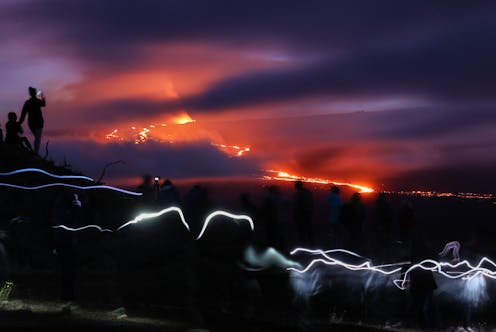
Hawaii’s largest and oldest volcano, Mauna Loa, began erupting on Nov. 27, 2022, with lava flowing miles away downhill. The last eruption, which lasted three weeks, was nearly 40 years ago.
It is not clear how long this eruption will last, but for many Native Hawaiians, it is a profound spiritual experience.
As an anthropologist, I have conducted nine studies on traditional Native American cultural relationships with volcanic lava flows. As in most Native American cultures, Native Hawaiians’ beliefs hold that Mauna Loa and other volcanoes are alive, and their eruptions are how the Earth is reborn. The volcano is like the Earth’s mother.
Since the volcano is alive, it must be treated like a person with rights and responsibilities and differently than if it were just flowing hot magma. Not just the volcano – all elements of the Earth are perceived as being alive, with feelings, the ability to speak and the power to do things they wish.
This view of the living Earth defines as alive the plants that grow on the volcano, the wind that passes over it, the birds that nest near it, the water that flows from it after rains and the oceans it touches.
The power of volcanoes
Native Hawaiians maintain that since the Earth’s creation, volcanoes’ elements – earth, wind and fire – have talked. They believe that these elements have humanlike rights, such as to be heard and to have goals. Crystals, obsidian, basalt boulders and other products of volcanic activity each are alive, and all have roles in the lives of humans.
Interactions between the earth elements, the volcano and humans are perceived as continuous because living natural elements change and thus need to adapt to new conditions together with each other and people.
Native American scholar and spokesperson Vine Deloria Jr. convened a Native Science of Volcanoes meeting in Albuquerque, New Mexico, in 2005. Among those who attended the meeting were this author and Native people from Washington state, Oregon, California, Arizona, Utah, Nevada and Hawaii, including elders from the Shoshone Bannock, Yakama, Owens Valley Paiute, Southern Paiute, Hopi, Nisqually, Winnemen-Wintu, Navajo and Klamath tribes.
These speakers said they regarded the volcanoes as living beings who, under certain circumstances, would share power and knowledge with humans. According to these elders, the volcano is a place where ceremonies are performed. The ceremonies are both an act of respect and a request for guidance.
Indigenous people believe their welfare and the Earth’s ecological balance are dependent on their continued and appropriate interactions with this living being.
Pilgrimage and rituals
Over tens of thousands of years, Native people have traveled to communicate with the same volcanoes during ceremonies. People traveled known physical and spiritual trails during these journeys.
Evidence shows that when pilgrims arrived at a destination volcano, they embedded the landscape with rock peckings, paintings, stone cairns, shrines, incised stones and many offerings. They sang and documented their relationship with the volcano.
During the mid-11th century lava flows at Sunset Crater, Arizona, and Little Spring, Arizona, people placed corn and painted pots on the edge of hornitos – conical structures produced by bubbling lava. When new lava splashes occurred, the resulting stones were embedded with corn imprints and pot shards. These were knocked off the edge before they could cool. The rocks were then taken to a nearby location and became a part of the walls of a ceremonial structure.
Management policies

Studies involving Native tribes and U.S. federal agencies have documented that the living Earth belief is broadly shared in North America and Hawaii. But Native peoples and their beliefs have not often been involved in land management policies and interpretations.
This, as I understand, is because of three main reasons: First, over the centuries, many Western scientists have believed that only they possess accurate knowledge about natural processes. Second, federal and state land managers have been given the legal responsibility to properly manage their parks and are reluctant to share power. And lastly, land managers don’t have the cultural knowledge to understand Native American beliefs or how to communicate with volcanoes.
Native people believe their ceremonial interactions with volcanoes result in the shared knowledge, which some call Native Science. They believe that volcanoes express ideas during ceremonies about how to keep themselves, the people and the world in balance. People can take this communication and act on it. But when Native beliefs are not perceived as science and thus not seen to be true or useful for management or interpretations, it creates what is known as an “epistemological divide. This hampers cross-cultural communication.
The eruptions of Mauna Loa are once again raising important questions about whether the volcano is a living being or inert. They also prompt questions about whether the eruption is for the benefit of humans or simply a threatening geological event that has no purpose.
The answer to these questions will influence how the volcano will be interpreted in the future for visitors and managed by geologists and environments.
Richard W Stoffle receives funding from various federal organizations.
This article was originally published on The Conversation. Read the original article.






